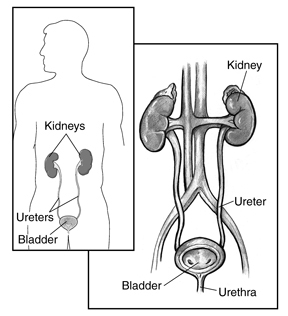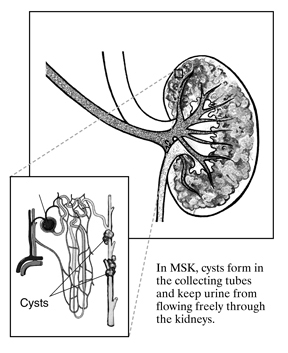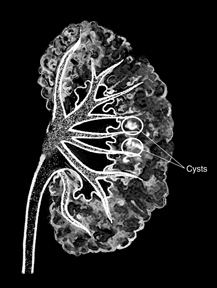

Medullary Sponge Kidney
On this page:
What is medullary sponge kidney?
Medullary sponge kidney (MSK) is a birth defect of the tubules—tiny tubes inside the kidneys. In a normal kidney, urine flows through these tubules as it is being formed. In MSK, tiny sacs called cysts form in the medulla—the inner part of the kidney—creating a sponge-like appearance. The cysts keep urine from flowing freely through the tubules.
MSK is present at birth but most cases do not appear to be inherited. Problems caused by MSK include hematuria, or blood in urine; kidney stones; and urinary tract infections (UTIs). But these problems do not usually appear until the ages of 30 to 40. MSK affects about 1 person per 5,000 to 20,000 people in the United States.1 Researchers have reported that up to 20 percent of people who form kidney stones have MSK.2 MSK rarely leads to more serious problems, such as total kidney failure.
1Glassberg KI. Renal dysgenesis and cystic disease of the kidney. In: Walsh PC, Retik AB, Vaughan ED, Wein AJ, eds. Campbell’s Urology. Vol. 3. 8th ed. Philadelphia: WB Saunders Company; 2002: 1925–1994.
2Grantham JJ, Nair V, Winklhoffer F. Cystic diseases of the kidney. In: Brenner BM, ed. Brenner & Rector’s The Kidney. Vol. 2. 6th ed. Philadelphia: WB Saunders Company; 2000: 1699–1730.
[Top]
What are the kidneys and what do they do?
The kidneys are two bean-shaped organs, each about the size of a fist. They are located on either side of the spine, just below the rib cage. The kidneys filter wastes and extra fluid from the blood to produce urine. They also release hormones that help control blood pressure and that keep blood and bones healthy.
Blood flows into the kidneys through two blood vessels called renal arteries. Inside the kidneys, the arteries branch off into smaller and smaller arteries. The smallest blood vessels intertwine with tubules that start to collect wastes and extra fluid from the blood. The point where the blood vessel and tubule intertwine is called a nephron. Each kidney contains about 1 million nephrons.

The kidneys remove wastes and extra fluid from the blood to form urine. Urine flows from the kidneys to the bladder through the ureters.
 
Urine leaves the nephron and drips through the tubules, which connect to increasingly larger tubules, and finally to the ureters, which are tubes that carry urine to the bladder.
In MSK, abnormal sacs called cysts form in the collecting tubes in the medulla of the kidneys. The cysts keep urine from flowing freely through the kidneys. UTIs and kidney stones can develop because the urine flow is blocked.
[Top]
What are the signs and symptoms of MSK?
For many people, MSK causes no symptoms. The first sign that a person has MSK is usually a UTI or kidney stone. UTIs and kidney stones share many of the same symptoms:
- burning or painful urination
- pain in the back, lower abdomen, or groin
- cloudy, dark, or bloody urine
- foul-smelling urine
- fever and chills
- vomiting
People who experience these symptoms should see a doctor as soon as possible.
[Top]
How is MSK diagnosed?
A doctor may suspect MSK when a person has repeated UTIs or kidney stones. To confirm the diagnosis, the doctor may order an x ray called an intravenous pyelogram (IVP). In an IVP, dye is injected into a vein. The dye travels through the blood to the kidneys. As the dye is filtered into the urinary tract, it makes urine visible on the x ray and shows any blockage in the urinary tract. Cysts show up as clusters of light in an IVP.

In an intravenous pyelogram of a medullary sponge kidney, cysts appear as clusters of light.
[Top]
How is MSK treated?
No treatment can get rid of cysts in the affected kidneys. Once a doctor is sure that a person has MSK, treatment focuses on curing existing infection, removing any stones, and preventing future infection and stone formation.
UTIs. To treat UTIs, the doctor may prescribe a medicine called an antibiotic that kills bacteria. A person with MSK may need to continue taking a low-dose antibiotic to prevent recurrent infections. Kidney stones. Stone removal may require a procedure called lithotripsy, which uses sound waves to break stones into sand-like particles. The particles can then pass easily through the urinary tract with the flow of urine. Another way to remove stones is to insert a thin tube called a ureteroscope through the urethra and bladder to catch the stone and retrieve it. A person with MSK may be able to prevent more stones from forming through diet changes or taking medicine. Increasing fluid intake so the person makes more urine is also very important to reduce the risk of new stone formation.
[Top]
Points to Remember
- Medullary sponge kidney (MSK) is a birth defect of the tubules inside the kidneys.
- Problems caused by MSK include hematuria, kidney stones, and urinary tract infections (UTIs).
- MSK problems do not usually appear until ages 30 to 40.
- Many people with MSK have no symptoms.
- Diagnosis of MSK may require an x ray called an intravenous pyelogram (IVP).
- No treatment can get rid of cysts in MSK.
- Treatment for MSK focuses on curing UTIs, removing kidney stones, and preventing recurrent infections and stones.
[Top]
Hope through Research
The National Institute of Diabetes and Digestive and Kidney Diseases (NIDDK) conducts and supports research into many kinds of kidney disease. NIDDK-supported researchers are exploring the genetic and molecular mechanisms that control kidney development in a fetus. These studies will point the way to more effective treatments for MSK and other kidney defects that are present at birth.
Participants in clinical trials can play a more active role in their own health care, gain access to new research treatments before they are widely available, and help others by contributing to medical research. For information
about current studies, visit www.ClinicalTrials.gov.
[Top]
For More Information
American Association of Kidney Patients
3505 East Frontage Road, Suite 315
Tampa, FL 33607
Phone: 1–800–749–2257
Fax: 813–636–8122
Email: info@aakp.org
Internet: www.aakp.org
American Kidney Fund
6110 Executive Boulevard, Suite 1010
Rockville, MD 20852
Phone: 1–800–638–8299
Fax: 301–881–0898
Email: helpline@kidneyfund.org
Internet: www.kidneyfund.org
Life Options Rehabilitation Resource Center
c/o Medical Education Institute, Inc.
414 D’Onofrio Drive, Suite 200
Madison, WI 53719
Phone: 1–800–468–7777
Email: lifeoptions@MEIresearch.org
Internet: www.lifeoptions.org
www.kidneyschool.org
National Kidney Foundation
30 East 33rd Street
New York, NY 10016
Phone: 1–800–622–9010 or 212–889–2210
Fax: 212–689–9261
Internet: www.kidney.org
The National Kidney and Urologic Diseases Information Clearinghouse collects resource information about kidney diseases for the NIDDK Reference Collection. This database provides titles, abstracts, and availability information for health information and health education resources.
You may view the results of the automatic search on medullary sponge kidney. If you wish to perform your own search of the database, go to NIDDK Reference Collection.
This publication may contain information about medications. When prepared, this publication included the most current information available. For updates or for questions about any medications, contact the U.S. Food and Drug Administration toll-free at 1–888–INFO–FDA (463–6332) or visit www.fda.gov. Consult your doctor for more information.
[Top]
National Kidney and Urologic Diseases Information Clearinghouse
3 Information Way
Bethesda, MD 20892–3580
Phone: 1–800–891–5390
TTY: 1–866–569–1162
Fax: 703–738–4929
Email: nkudic@info.niddk.nih.gov
Internet: www.kidney.niddk.nih.gov
The National Kidney and Urologic Diseases Information Clearinghouse (NKUDIC) is a service of the National Institute of Diabetes and Digestive and Kidney Diseases (NIDDK). The NIDDK is part of the National Institutes of Health of the U.S. Department of Health and Human Services. Established in 1987, the Clearinghouse provides information about diseases of the kidneys and urologic system to people with kidney and urologic disorders and to their families, health care professionals, and the public. The NKUDIC answers inquiries, develops and distributes publications, and works closely with professional and patient organizations and Government agencies to coordinate resources about kidney and urologic diseases.
Publications produced by the Clearinghouse are carefully reviewed by both NIDDK scientists and outside experts. This publication was reviewed by the following members of the American Society of Pediatric Nephrology Clinical Affairs Committee for their review of this fact sheet: Deepa Chand, M.D.; Maria Ferris, M.D.; Joseph Flynn, M.D., M.S.; Keith Lau, M.D.; Tej Mattoo, M.D.; Asha Mougdil, M.D.; and Robert Weiss, M.D.
This publication is not copyrighted. The Clearinghouse encourages users of this publication to duplicate and distribute as many copies as desired.
NIH Publication No. 08–6235
July 2008
[Top]
|






